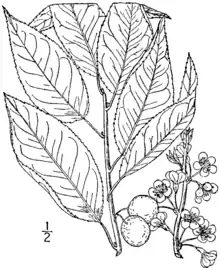Prunus alleghaniensis
Prunus alleghaniensis, the Allegheny plum,[2] is a species of New World plum, native to the Appalachian Mountains from New York to Kentucky and North Carolina, plus the Lower Peninsula of Michigan. There are old reports of it growing also in New Jersey and Connecticut, but it now appears to have been extirpated in those two states.[3][4][5][6]
| Prunus alleghaniensis | |
|---|---|
 | |
| 1913 illustration[1] | |
| Scientific classification | |
| Kingdom: | Plantae |
| Clade: | Tracheophytes |
| Clade: | Angiosperms |
| Clade: | Eudicots |
| Clade: | Rosids |
| Order: | Rosales |
| Family: | Rosaceae |
| Genus: | Prunus |
| Subgenus: | Prunus subg. Prunus |
| Section: | Prunus sect. Prunocerasus |
| Species: | P. alleghaniensis |
| Binomial name | |
| Prunus alleghaniensis | |
Description
Prunus alleghaniensis is a shrub or small tree 3–12 feet (91–366 centimetres) tall. The leaves of are two to three and a half inches (5.0-8.8 cm) long, the tip is usually long and pointed. The leaf margins are finely toothed. The twigs sometimes have thorns. The bark is fissured in older specimens. The flowers are plentiful and white, eventually turning pink. The dark reddish purple fruit is half an inch (13 mm) wide, with a whitish bloom.[7]
Habitat
Prunus alleghaniensis is not common in moist woodlands. It is typically found in elevations between 1,200 and 2,000 feet (370 and 610 meters).
Uses
The fruit is made into preserves and jelly.[8]
References
- USDA-NRCS PLANTS Database / Britton, N.L., and A. Brown. 1913. An illustrated flora of the northern United States, Canada and the British Possessions. 3 vols. Charles Scribner's Sons, New York. Vol. 2: 324.
- "Prunus alleghaniensis". Natural Resources Conservation Service PLANTS Database. USDA. Retrieved 14 October 2015.
- "ITIS Standard Report Page: Prunus alleghaniensis". Integrated Taxonomic Information System. Retrieved 20 December 2010.
- "Prunus alleghaniensis". National Center for Biotechnology Information. Retrieved 20 December 2010.
- Biota of North America Program 2014 county distribution map
- Kershner, Mathews, Nelson & Spellenburg, "Field Guide to Trees of North America", (Sterling Publishing Co, New York, New York, 2008), p. 344-345, accessed the 18th of December, 2010
- Porter, Thomas Conrad 1877. Botanical Gazette 2(5): 85
- Little, Elbert L. (1980). The Audubon Society Field Guide to North American Trees: Eastern Region. New York: Knopf. p. 493. ISBN 0-394-50760-6.
External links
| Wikimedia Commons has media related to Prunus alleghaniensis. |
